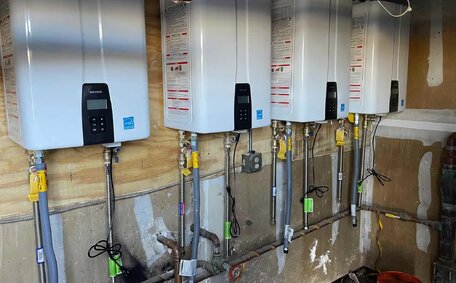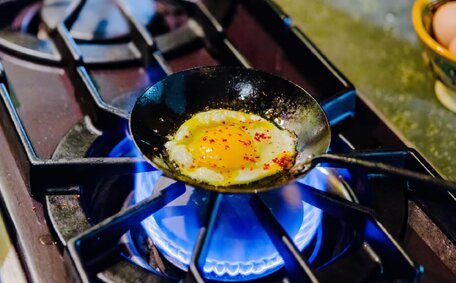Understanding Your Hot Water System
Having an efficient hot water system is key to managing your energy use and bills. There are a few main types of systems that heat water for your home - electric, gas, heat pump, and solar. Each system operates uniquely, yet they share common factors that affect efficiency:
- The temperature setting
- Insulation around the tank or pipes
- Household hot water usage
- System upgrades
It’s common to set the water heater temperature unnecessarily high, between 60-65°C. Reducing the temperature by 10°C can cut water heating costs by as much as 5%.
A lower temperature setting can conserve energy without sacrificing your comfort. Aim for 50-55°C, or even 48°C in warmer climates. This temperature is sufficient to eliminate Legionella bacteria.
Insulating exposed hot water pipes and older storage tanks stops a lot of heat from being lost. An inexpensive insulation jacket around your electric or gas tank can make a noticeable difference. For heat pumps and water heater systems, ensure any external pipes are insulated.
Consider whether your current tank or system size matches your household’s occupancy and hot water needs. Upgrades to more efficient systems can also help in the longer term.
Reducing excessive tank capacity can further decrease bills.
Simple modifications can enhance the efficiency of your existing hot water system. And by being water wise in the home, you can reduce the amount of heating needed overall.
Storage vs Continuous Flow Systems
The primary home hot water systems are storage tanks and continuous flow systems, also known as tankless or on-demand.
Storage tanks heat and store a set amount of hot water. They work by heating a tank of water to the set temperature, then maintaining it there. Common storage tank water heaters run on electricity or gas.
Continuous flow systems quickly heat water on demand to the desired temperature, eliminating the need for a storage tank. Cold water passes across a heat exchanger that warms it to your set temperature. They only heat the water being used.
A notable efficiency factor is standby losses, where storage tanks lose heat by maintaining water temperature even when not in use. Continuous flow systems circumvent this by heating only the required water.
A continuous flow system should be set no higher than 50°C to ensure energy efficiency and prevent water from overheating before reaching your taps.
Optimal Temperature Settings
The optimal thermostat setting is key to energy savings and safe water use, balancing the prevention of Legionella bacteria with avoiding wasteful overheating of water, which should be ideally below 60°C.
Set your storage tank’s thermostat to 50-60°C for a good balance between energy efficiency and safety.
For continuous flow systems, there’s no need for a higher temperature than 50°C as water gets heated instantly on demand. Higher settings simply overheat water between the heater and taps.
Ensure your system operates within the safe temperature range recommended in your owner’s manual, ideally around 60°C for storage systems. But small adjustments within safe levels can yield worthwhile savings from reduced standby heating losses.
Also consider an inexpensive tank insulation blanket, which allows slightly lower thermostat settings without compromising delivery times or bacterial control. Insulate any exposed external pipes too.
Preventing Bacterial Growth
Without proper maintenance, hot water systems can become breeding grounds for hazardous bacteria such as Legionella. Legionella thrive at temperatures between 20-50°C, and can cause serious lung infections when inhaled in water vapour.
Always set storage hot water systems at a minimum of 60°C to prevent bacteria proliferation. Temperatures lower than this risk allowing Legionella colonies to form in the tank. Setting storage systems above 60°C does not enhance bacterial control but does significantly increase energy consumption.
Continuous flow systems deliver water instantly heated when needed, so bacterial growth in internal pipes isn’t an issue. But take care to disinfect infrequently used taps or shower heads downstream, as stagnant pipework can still enable Legionella to multiply at cooler temperatures.
Other ways to prevent bacteria include:
- Annual servicing and system inspection
- Flushing through infrequent outlets, where you might able to clear out any debris or buildup
- Tank disinfection if ever offline below 60°C for >1 week
- Checking expansion control and temp/pressure relief valves
Balancing bacterial control and energy savings comes down to proper temp settings of about 60°C for storage systems, and no higher than 50°C for continuous flow units. Insulate tanks and pipes too. With a few precautions, hot water systems can safely deliver efficient hydrotherapy for households.
Avoiding Scalds
Safety is as essential as efficiency when managing your hot water system’s temperature to avoid the risk of scalding. Reducing energy in your hot water system not only saves costs but also can prevent serious burns within seconds for those most vulnerable, like children and the elderly.
To prevent scalding, ensure your hot water system, particularly continuous flow types, is never set above 50 degrees Celsius. The temperature of the water from a continuous flow system is governed by water pressure and flow rate.
If pressure falls, such as when using several taps, the heater might continue high output, resulting in excessively hot water.
Mixing valves or tempering devices help regulate the temperature of your water, essential for safety. These devices mix hot and cold water to deliver water at a safe temperature, usually around 50 degrees Celsius. Make sure yours are working effectively and are installed in the correct location.
One way to check your tempering device is by running the hot water in several taps and showers for a few minutes. Then, measure the temperature at each outlet – If it exceeds 50 degrees Celsius, your tempering device may need servicing or replacing.
Regularly adjusting and maintaining your safety features ensures water remains within a safe temperature range. This includes checking pressure relief valves and tempering devices to prevent malfunctions and scalding due to unforeseen circumstances.
By prioritising safety alongside energy efficiency, you can reduce the amount of risk to your loved ones while ensuring that your hot water remains a comfortable and reliable luxury.
Insulating Your Hot Water System
Wrapping Tanks
Insulating electric or gas hot water storage tanks is one of the most effective ways to improve efficiency. Minimise heat loss with a proper insulation jacket, as tanks can lose substantial heat without one.
Common insulation materials for gas electric systems are polyurethane, polyethylene foam or fibreglass wraps. Secure these around the tank with a tough outer cover. Do-it-yourself kits are readily available from hardware stores and plumbing suppliers.
Using an insulation blanket can reduce standby heat loss by up to 45%. For maximum efficiency, cover the tank completely, sparing only the water inlet, outlet, and thermostat.
Insulating Pipes
Insulating hot water pipes can also ease the strain on your energy bills by reducing wasted heat in transfer. This keeps more heat in the water getting to your taps.
Apply quality pipe insulation to as much of the hot water pipework as possible, particularly pipes more than 1-2m long. Sections closest to the tank and exposed external pipework often waste the most heat if uninsulated.
Select insulation that matches the necessary temperature rating and thickness for household water pipes. Secure it tightly to optimise efficiency. Install insulation with durable PVC outer layers for longevity and weather resistance.
Regular Maintenance
Draining and Flushing
Draining your storage hot water system annually can reduce your maintenance woes by getting rid of sediment buildup. This sediment reduces heating efficiency and capacity over time.
Begin by turning off the power or gas, and then attach a hose to the tank’s drain valve. Open the pressure and temperature relief valve to allow air in.
Draining the tank fully before closing valves and refilling will effectively reduce sediment accumulation, enhancing system efficiency.
Servicing Valves and Heating Elements
Check your pressure and temperature relief valves every six months to guarantee they are functioning properly. Ensure safety by leading the drain hose into a ground-placed bucket.
For electric systems, periodically checking or replacing heating elements can reduce energy use and extend the system’s life.
Turn off power first, then open the access panel. A white crusty mineral coating indicates calcium and magnesium buildup. Turn off power first, then open the access panel.
Replace elements showing signs of corrosion or damage. Heating elements typically last 4-5 years. Professionals can test elements using a multimeter to check if replacement is due.
Regular servicing is crucial to maintain efficiency, safety and an adequate hot water supply, preventing the system from operating at excessive temperatures. Maintain valves, heating elements and insulation in good working order.
Upgrading For Efficiency
If your hot water system is over 10 years old, upgrading to a more efficient model can deliver worthwhile energy and cost savings. Installing a new continuous flow gas system or heat pump unit are common upgrade options offering improved efficiency. Solar thermal systems are another possibility if you have the roof space.
Heat Pumps
Heat pump hot water systems are very energy efficient. They extract free heat from ambient air to help heat water - using around half as much power as a conventional electric storage tank. Installation is similar to standard electric units, only requiring an outdoor heat pump unit mounted on an exterior wall.
Solar Systems
Solar hot water systems have roof-mounted solar collectors that harness the sun’s thermal energy to preheat water. This means much less backup heating is required from the electric elements or gas burner, saving energy.
High-performing solar hot water systems now eligible for federal government rebates, making installation more affordable. Contact our team at Colyton Plumbing to explore whether solar hot water is right for your home and situation.
Modernising your hot water system with a more advanced model can lead to significant improvements in efficiency and cost savings. Consult Colyton Plumbing to understand your options and install an energy-saving hot water system optimised for your household.






